Analysis of a Collaborative Scheduling Model Applied in a Job Shop Manufacturing Environment
Abstract
1. Introduction
2. Manufacturing Scheduling Evolution
2.1. Scheduling Problems and Solving Approaches
2.2. The Jackson’s Scheduling Model
- Machine A: {A,B} -> {A} -> {B,A}
- Machine B: {B,A} -> {B} -> {A,B}
2.3. Scheduling Process Complexity
3. Interoperable Manufacturing Scheduling System
3.1. Scheduling System Architecture
3.2. Ilustrative Scheduling System Interface
4. Collaborative Scheduling
4.1. Proposed Scheduling Model
- Work Center A
- Sequence 1:
- {A,B,C}->{A,C,B}->{B,A,C}->{A,B}->{A,C}->{A}->{C,A}->{B,A}->{C,A,B}->{B,C,A}->{C,B,A}
- Sequence 2:
- {A,C,B}->{A,B,C}->{B,A,C}->{A,B}->{A,C}->{A}->{C,A}->{B,A}->{C,A,B}->{C,B,A}->{B,C,A}
- Sequence 3:
- {A,B,C}->{A,C,B}->{B,A,C}->{A,C}->{A,B}->{A}->{B,A}->{C,A}->{C,A,B}->{B,C,A}->{C,B,A}
- Sequence 4:
- {A,C,B}->{A,B,C}->{B,A,C}->{A,C}->{A,B}->{A}->{B,A}->{C,A}->{B,A,C}->{C,B,A}->{B,C,A}
- Work center B
- Sequence 1:
- {B,A,C}->{B,C,A}->{A,B,C}->{B,A}->{B,C}->{B}->{C,B}->{A,B}->{C,B,A}->{A,C,B}->{C,A,B}
- Sequence 2:
- {B,C,A}->{B,A,C}->{A,B,C}->{B,A}->{B,C}->{B}->{C,B}->{A,B}->{C,B,A}->{C,A,B}->{A,C,B}
- Sequence 3:
- {B,A,C}->{B,C,A}->{A,B,C}->{B,C}->{B,A}->{B}->{A,B}->{C,B}->{C,B,A}->{A,C,B}->{C,A,B}
- Sequence 4:
- {B,C,A}->{B,A,C}->{A,B,C}->{B,C}->{B,A}->{B}->{A,B}->{C,B}->{C,B,A}->{C,A,B}->{A,C,B}
- Work center C
- Sequence 1:
- {C,A,B}->{C,B,A}->{B,C,A}->{C,A}->{C,B}->{C}->{B,C}->{A,C}->{A,C,B}->{A,B,C}->{B,A,C}
- Sequence 2:
- {C,B,A}->{C,A,B}->{B,C,A}->{C,A}->{C,B}->{C}->{B,C}->{A,C}->{A,C,B}->{B,A,C}->{A,B,C}
- Sequence 3:
- {C,A,B}->{C,B,A}->{B,C,A}->{C,B}->{C,A}->{C}->{A,C}->{B,C}->{A,C,B}->{A,B,C}->{B,A,C}
- Sequence 4:
- {C,B,A}->{C,A,B}->{B,C,A}->{C,B}->{C,A}->{C}->{A,C}->{B,C}->{A,C,B}->{B,A,C}->{A,B,C}
5. Scheduling Case Study in a Job Shop Environment under Three Different Scenarios
5.1. Internal Performance Oriented Approaches–Scenario 1
5.2. External Performance Oriented Approaches–Scenario 2
5.3. Combined Performance Oriented Approaches–Scenario 3
6. Scheduling Model Application Analysis and Discussion
7. Conclusions
Author Contributions
Funding
Institutional Review Board Statement
Informed Consent Statement
Data Availability Statement
Acknowledgments
Conflicts of Interest
References
- Putnik, G.D.; Putnik, Z.; Shah, V.; Varela, L.; Ferreira, L.; Castro, H.; Catia, A.; Pinheiro, P. Collaborative Engineering definition: Distinguishing it from Concurrent Engineering through the complexity and semiotics lenses. IOP Conf. Ser. Mater. Sci. Eng. 2021, 1174, 012027. [Google Scholar] [CrossRef]
- Putnik, G.D.; Putnik, Z.; Shah, V.; Varela, L.; Ferreira, L.; Castro, H.; Catia, A.; Pinheiro, P. Collaborative Engineering: A Review of Organisational Forms for Implementation and Operation. IOP Conf. Ser. Mater. Sci. Eng. 2021, 1174, 012028. [Google Scholar] [CrossRef]
- Eijnatten, F.M.; Putnik, G.D. Chaos, Complexity, Learning, and the Learning Organization: Towards a Chaordic Enterprise; Emerald Group Publishing: Bingley, UK, 2004. [Google Scholar]
- Lou, P.; Ong, S.K.; Nee, A.Y.C. Agent-based distributed scheduling for virtual job shops. Int. J. Prod. Res. 2010, 48, 3889–3910. [Google Scholar] [CrossRef]
- Vieira, G.; Varela, M.L.R.; Putnik, G.D. Technologies integration for distributed manufacturing scheduling in a virtual enterprise. In International Conference on Virtual and Networked Organizations, Emergent Technologies, and Tools; Springer: Berlin/Heidelberg, Germany, 2012; pp. 337–347. [Google Scholar]
- Canadas, N.; Machado, J.; Soares, F.; Barros, C.; Varela, L. Simulation of cyber physical systems behaviour using timed plant models. Mechatronics 2018, 54, 175–185. [Google Scholar] [CrossRef]
- Kays, H.M.E.; Karim, A.N.M.; Daud, M.R.C.; Varela, M.L.R.; Putnik, G.D.; Machado, J.M. A collaborative multiplicative Holt-Winters forecasting approach with dynamic fuzzy-level component. Appl. Sci. 2018, 8, 530. [Google Scholar] [CrossRef]
- Putnik, G.D.; Ferreira, L.G.M. Industry 4.0: Models, tools and cyber-physical systems for manufacturing. FME Trans. 2019, 47, 659–662. [Google Scholar] [CrossRef]
- Deloitte, 2012. Retail Globalization. Deloitte Touche Tohmatsu Limited. Available online: https://www.deloitte.com/global/en.html (accessed on 17 October 2022).
- Hankel, M.; Rexroth, B. The reference architectural model industrie 4.0 (rami 4.0). ZVEI 2015, 2, 4–9. [Google Scholar]
- Kagermann, H. Change through digitization—Value creation in the age of Industry 4.0. In Management of Permanent Change; Springer Gabler: Wiesbaden, Germany, 2015; pp. 23–45. [Google Scholar]
- Li, L. China’s manufacturing locus in 2025: With a comparison of “Made-in-China 2025” and “Industry 4.0”. Technol. Forecast. Soc. Chang. 2018, 135, 66–74. [Google Scholar] [CrossRef]
- Sony, M.; Naik, S.S. Ten lessons for managers while implementing Industry 4.0. IEEE Eng. Manag. Rev. 2019, 47, 45–52. [Google Scholar] [CrossRef]
- Jackson, J.R. An extension of Johnson’s results on job lot scheduling. Nav. Res. Logist. Q. 1956, 3, 201–203. [Google Scholar] [CrossRef]
- Arrais-Castro, A.; Varela ML, R.; Putnik, G.D.; Ribeiro, R.A.; Machado, J.; Ferreira, L. Collaborative framework for virtual organisation synthesis based on a dynamic multi-criteria decision model. Int. J. Comput. Integr. Manuf. 2018, 31, 857–868. [Google Scholar] [CrossRef]
- Reddy, M.S.; Ratnam, C.; Agrawal, R.; Varela, M.L.R.; Sharma, I.; Manupati, V.K. Investigation of reconfiguration effect on makespan with social network method for flexible job shop scheduling problem. Comput. Ind. Eng. 2017, 110, 231–241. [Google Scholar] [CrossRef]
- Alves, F.; Varela, M.L.R.; Rocha, A.M.A.; Pereira, A.I.; Leitão, P. A human centered hybrid MAS and meta-heuristics based system for simultaneously supporting scheduling and plant layout adjustment. FME Trans. 2019, 47, 699–710. [Google Scholar] [CrossRef]
- Azevedo, B.F.; Varela, M.L.R.; Pereira, A.I. Production Scheduling Using Multi-objective Optimization and Cluster Approaches. In Proceedings of the International Conference on Innovations in Bio-Inspired Computing and Applications, Online, 16–18 December 2021; pp. 120–129. [Google Scholar]
- Shen, W.; Wang, L.; Hao, Q. Agent-based distributed manufacturing process planning and scheduling: A state-of-the-art survey. IEEE Trans. Syst. Man Cybern. Part C 2006, 36, 563–577. [Google Scholar] [CrossRef]
- Manupati, V.K.; Gokula Krishnan, M.; Varela, M.L.R.; Machado, J. Telefacturing based distributed manufacturing environment for optimal manufacturing service by enhancing the interoperability in the hubs. J. Eng. 2017, 2017, 9305989. [Google Scholar] [CrossRef]
- Fu, Y.; Wang, H.; Huang, M. Integrated scheduling for a distributed manufacturing system: A stochastic multi-objective model. Enterp. Inf. Syst. 2019, 13, 557–573. [Google Scholar] [CrossRef]
- Cheng, Y.; Bi, L.; Tao, F.; Ji, P. Hypernetwork-based manufacturing service scheduling for distributed and collaborative manufacturing operations towards smart manufacturing. J. Intell. Manuf. 2020, 31, 1707–1720. [Google Scholar] [CrossRef]
- Zhou, R.; Chen, G.; Yang, Z.H.; Zhang, J.B. Distributed manufacturing scheduling using a novel cooperative system. In Proceedings of the 2008 IEEE International Conference on Service Operations and Logistics, and Informatics, Beijing, China, 12–15 October 2008; Volume 1, pp. 256–260. [Google Scholar]
- Baker, K.R.; Trietsch, D. Safe scheduling: Setting due dates in single-machine problems. Eur. J. Oper. Res. 2009, 196, 69–77. [Google Scholar] [CrossRef]
- Pinedo, M.; Chao, X. Operations Scheduling with Applications in Manufacturing and Services; McGraw Hill: New York, NY, USA, 1999. [Google Scholar]
- Pinedo, M.L. Scheduling Theory, Algorithms and Systems, 4th ed.; Springer: Berlin/Heidelberg, Germany, 2012. [Google Scholar]
- Mishra, N.; Singh, A.; Kumari, S.; Govindan, K.; Ali, S.I. Cloud-based multi-agent architecture for effective planning and scheduling of distributed manufacturing. Int. J. Prod. Res. 2016, 54, 7115–7128. [Google Scholar] [CrossRef]
- Zhang, X.; Liu, X.; Tang, S.; Królczyk, G.; Li, Z. Solving scheduling problem in a distributed manufacturing system using a discrete fruit fly optimization algorithm. Energies 2019, 12, 3260. [Google Scholar] [CrossRef]
- Mao, X.; Li, J.; Guo, H.; Wu, X. Research on Collaborative Planning and Symmetric Scheduling for Parallel Shipbuilding Projects in the Open Distributed Manufacturing Environment. Symmetry 2020, 12, 161. [Google Scholar] [CrossRef]
- Zijm, W.H.M. The integration of process planning and shop floor scheduling in small batch part manufacturing, Ann. CIRP 1995, 44, 429–432. [Google Scholar] [CrossRef]
- Shen, Y.J.; Wang, M.S. Broadcast scheduling in wireless sensor networks using fuzzy Hopfield neural network. Expert Syst. Appl. 2008, 34, 900–907. [Google Scholar] [CrossRef]
- Madureira, A.; Ramos, R.; Carmo Silva, S. Using Genetic Algorithms for Dynamic Scheduling. In Proceedings of the 14th Annual Production and Operations Management Society Conference (POMS’2003), Savannah, GA, USA, 4–7 April 2003. [Google Scholar]
- Alves, C.; Putnik, G.D.; Varela, M.L.R. How environment dynamics affects production scheduling: Requirements for development of CPPS models. FME Trans. 2021, 49, 827–834. [Google Scholar] [CrossRef]
- Goren, S.; Sabuncuoglu, I. Robustness and Stability Measures for Scheduling: Single Machine Environments. IIE Trans. 2008, 40, 66–83. [Google Scholar] [CrossRef]
- Ouelhadj, D.; Petrovic, S. A Survey of Dynamic Scheduling in Manufacturing Systems. J. Sched. 2009, 12, 417–431. [Google Scholar] [CrossRef]
- Aytug, H.; Lawley, M.A.; McKay, K.; Mohan, S.; Uzsoy, R. Executing production schedules in the face of uncertainties: A review and some future directions. Eur. J. Oper. Res. 2005, 161, 86–110. [Google Scholar] [CrossRef]
- Shen, W. Distributed manufacturing scheduling using intelligent agents. IEEE Intell. Syst. 2002, 17, 88–94. [Google Scholar] [CrossRef]
- Saeidlou, S.; Saadat, M.; Amini Sharifi, E.; Jules, G.D. Agent-based distributed manufacturing scheduling: An ontological approach. Cogent Eng. 2019, 6, 1565630. [Google Scholar] [CrossRef]
- Ramakurthi, V.B.; Manupati, V.K.; Machado, J.; Varela, L. A hybrid multi-objective evolutionary algorithm-based semantic foundation for sustainable distributed manufacturing systems. Appl. Sci. 2021, 11, 6314. [Google Scholar] [CrossRef]
- Guo, Z.; Ngai, E.; Yang, C.; Liang, X. An RFID-based intelligent decision support system architecture for production monitoring and scheduling in a distributed manufacturing environment. Int. J. Prod. Econ. 2015, 159, 16–28. [Google Scholar] [CrossRef]
- Varela, M.L.R.; Putnik, G.D.; Manupati, V.K.; Rajyalakshmi, G.; Trojanowska, J.; Machado, J. Integrated process planning and scheduling in networked manufacturing systems for I4.0: A review and framework proposal. Wirel. Netw. 2021, 27, 1587–1599. [Google Scholar] [CrossRef]
- Chiu, C.; Yih, Y. A learning-based methodology for dynamic scheduling in distributed manufacturing systems. Int. J. Prod. Res. 1995, 33, 3217–3232. [Google Scholar] [CrossRef]
- Varela, M.L.R.; Ribeiro, R.A. Distributed Manufacturing Scheduling Based on a Dynamic Multi-criteria Decision Model. In Recent Developments and New Directions in Soft Computing; Zadeh, L., Abbasov, A., Yager, R., Shahbazova, S., Reformat, M., Eds.; Studies in Fuzziness and Soft Computing; Springer: Cham, Switzerland, 2014; p. 317. [Google Scholar] [CrossRef]
- Vafaei, N.; Ribeiro, R.A.; Camarinha-Matos, L.M.; Varela, L.R. Normalization techniques for collaborative networks. Kybernetes 2019, 49, 1285–1304. [Google Scholar] [CrossRef]
- Santos, A.S.; Madureira, A.M.; Varela, M.L.R. An ordered heuristic for the allocation of resources in unrelated parallel-machines. Int. J. Ind. Eng. Comput. 2015, 6, 145–156. [Google Scholar]
- Putnik, G.D.; Pabba, S.K.; Manupati, V.K.; Varela, M.L.R.; Ferreira, F. Semi-Double-loop machine learning based CPS approach for predictive maintenance in manufacturing system based on machine status indications. CIRP Ann. Manuf. Technol. 2021, 70, 365–368. [Google Scholar] [CrossRef]
- Varela, M.L.R.; Amaral, G.; Pereira, S.; Machado, D.; Falcão, A.; Ribeiro, R.; Sousa, E.; Santos, J.; Pereira, A.F. Interoperable Decision Support System based on Multivariate Time Series for Setup Data Processing and Visualization. In Proceedings of the 19th International on Intelligent Systems Design and Applications (ISDA 2019), Auburn, WA, USA, 3–5 December2019; Advances in Intelligent Systems and Computing. Springer: Cham, Switzerland, 2019; pp. 550–560. [Google Scholar]
- Ignall, E.; Schrage, L. Application of the branch and bound technique to some flow-shop scheduling problems. Oper. Res. 1965, 13, 400–412. [Google Scholar] [CrossRef]
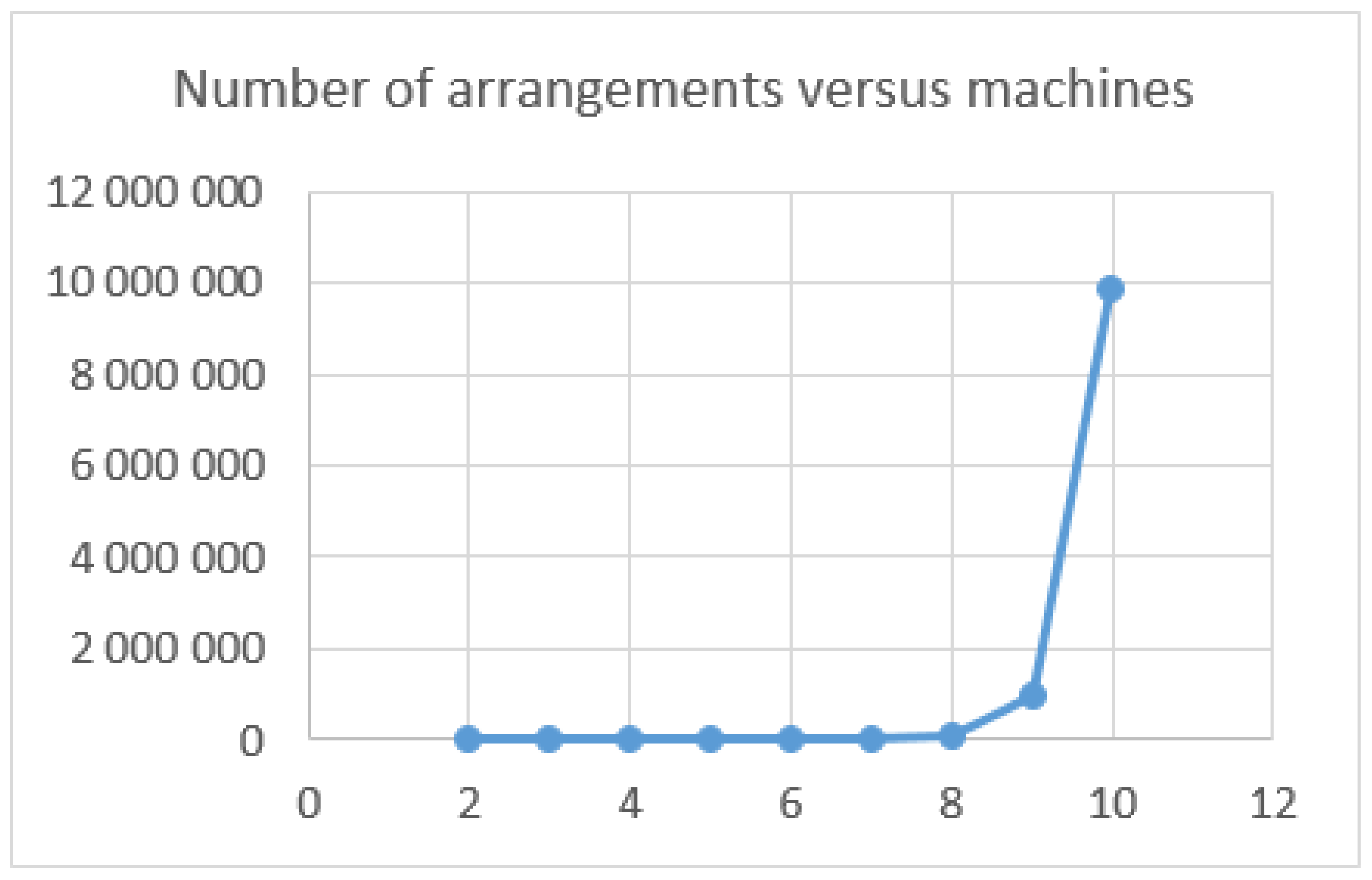
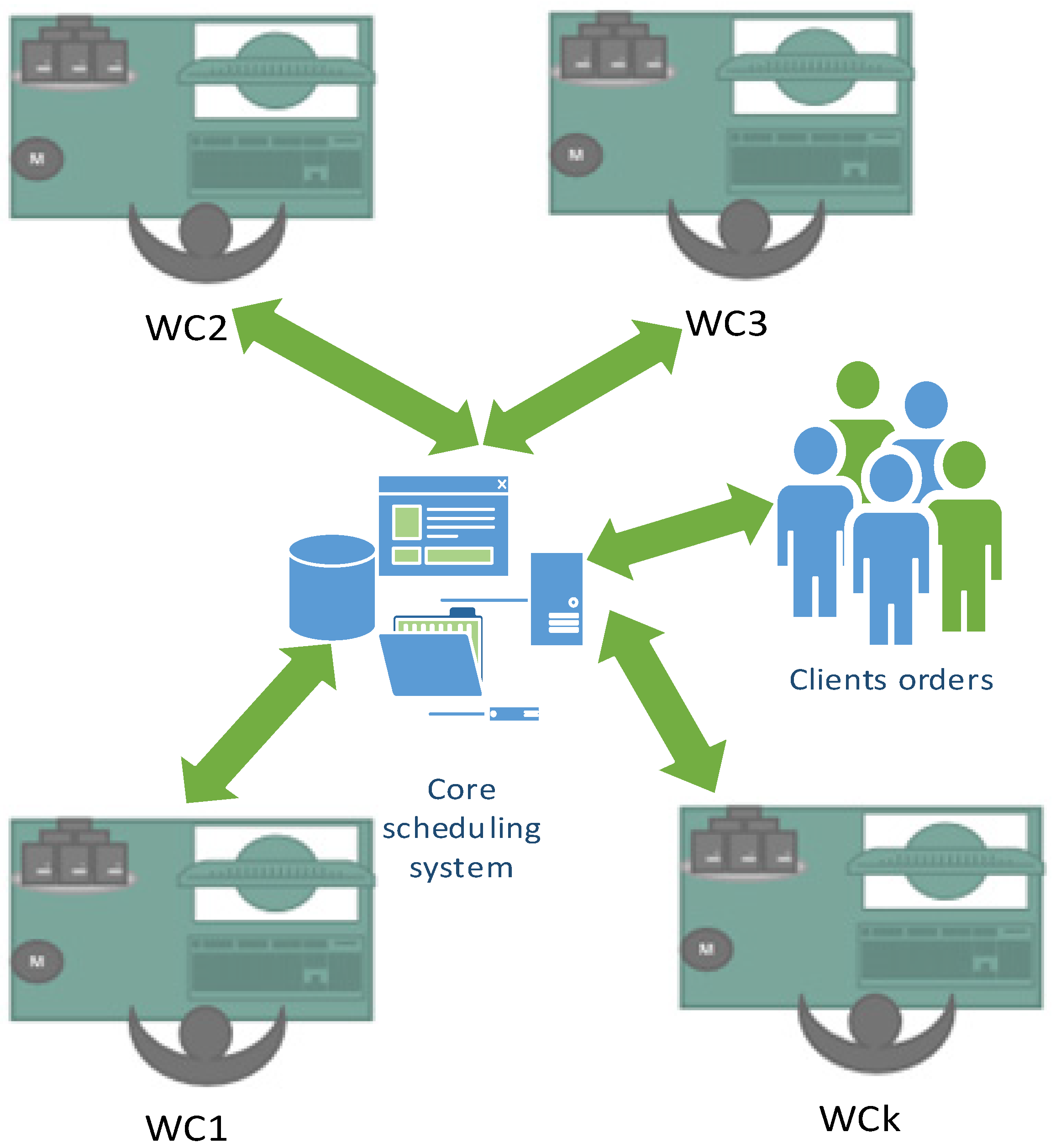
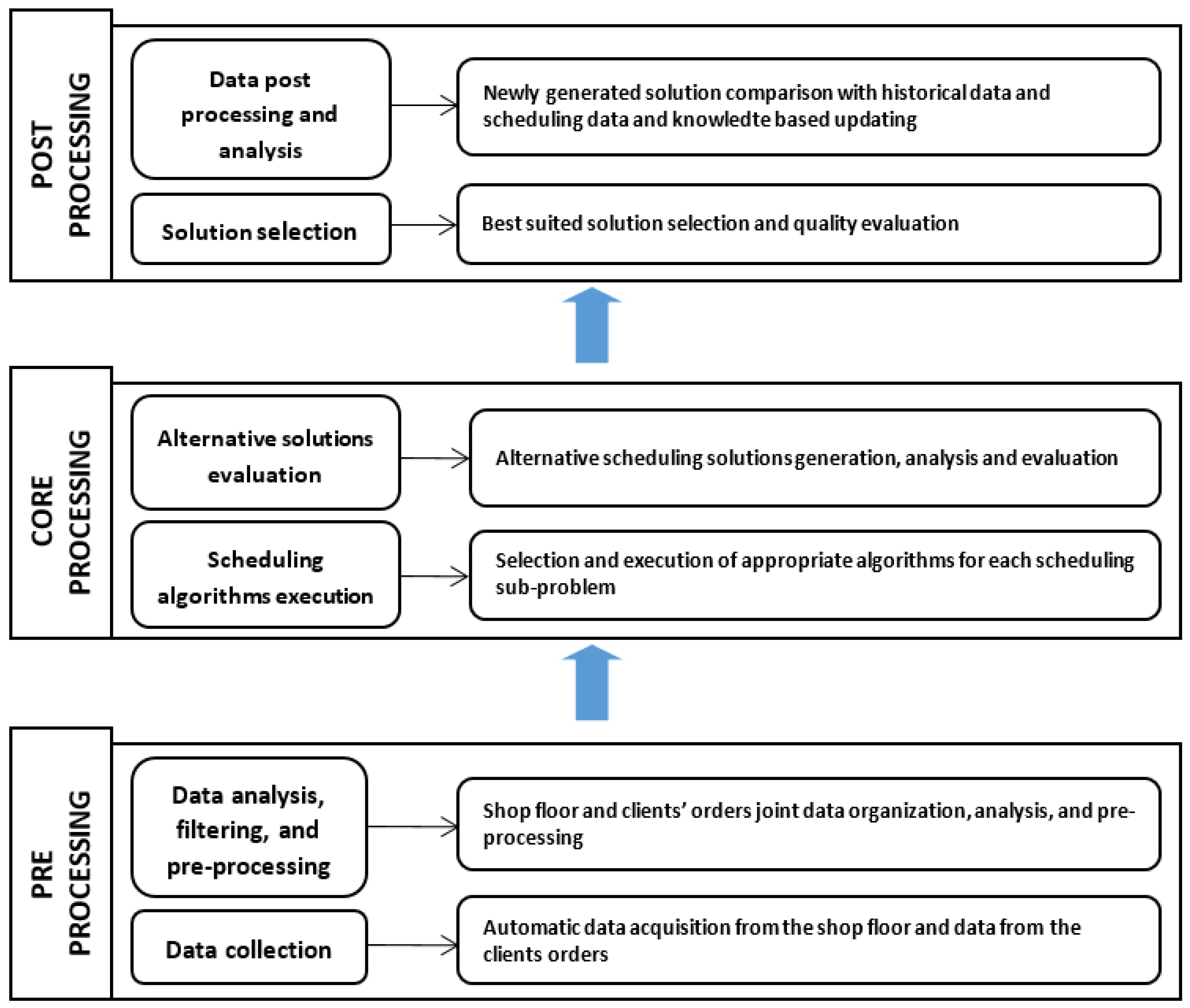
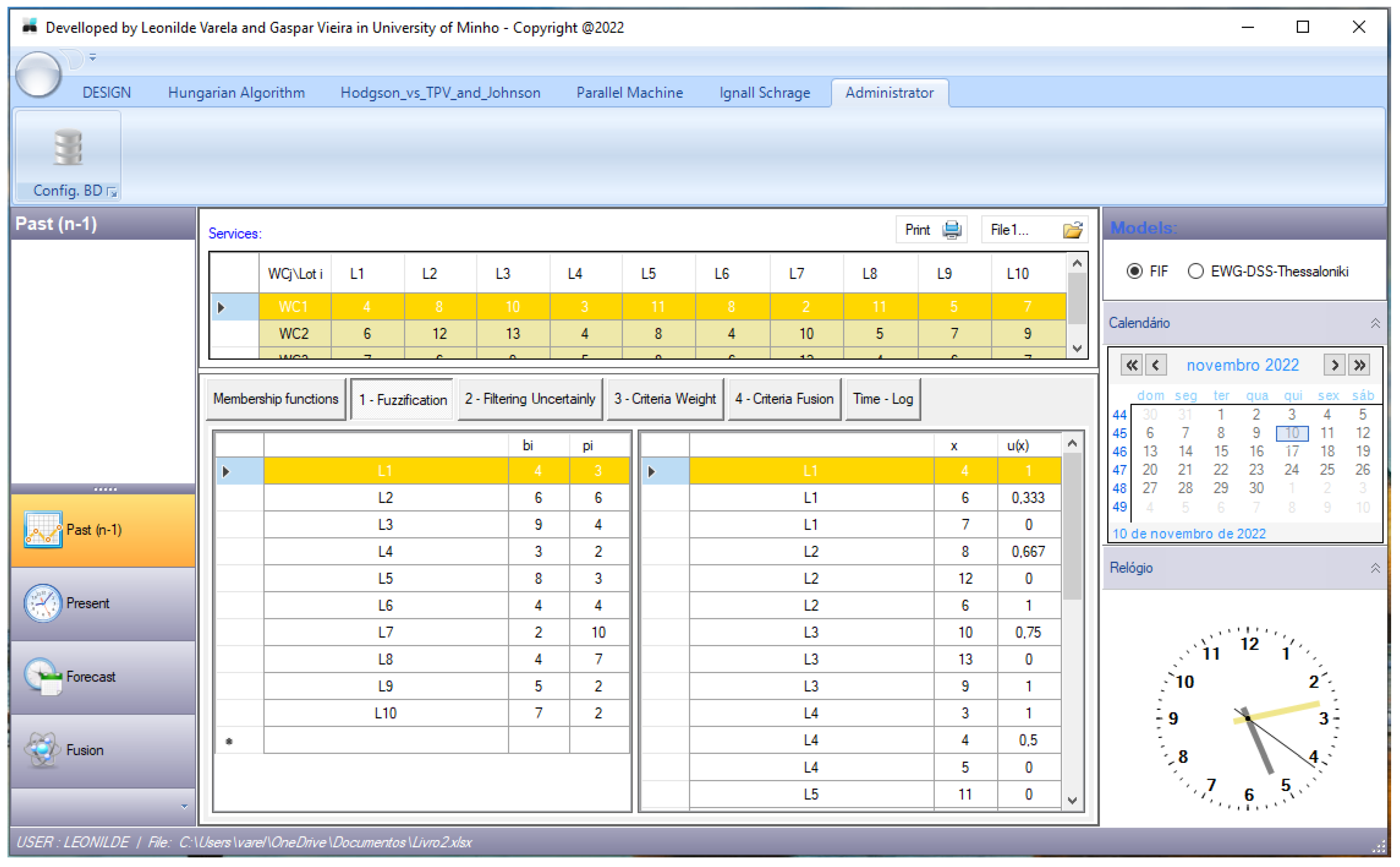

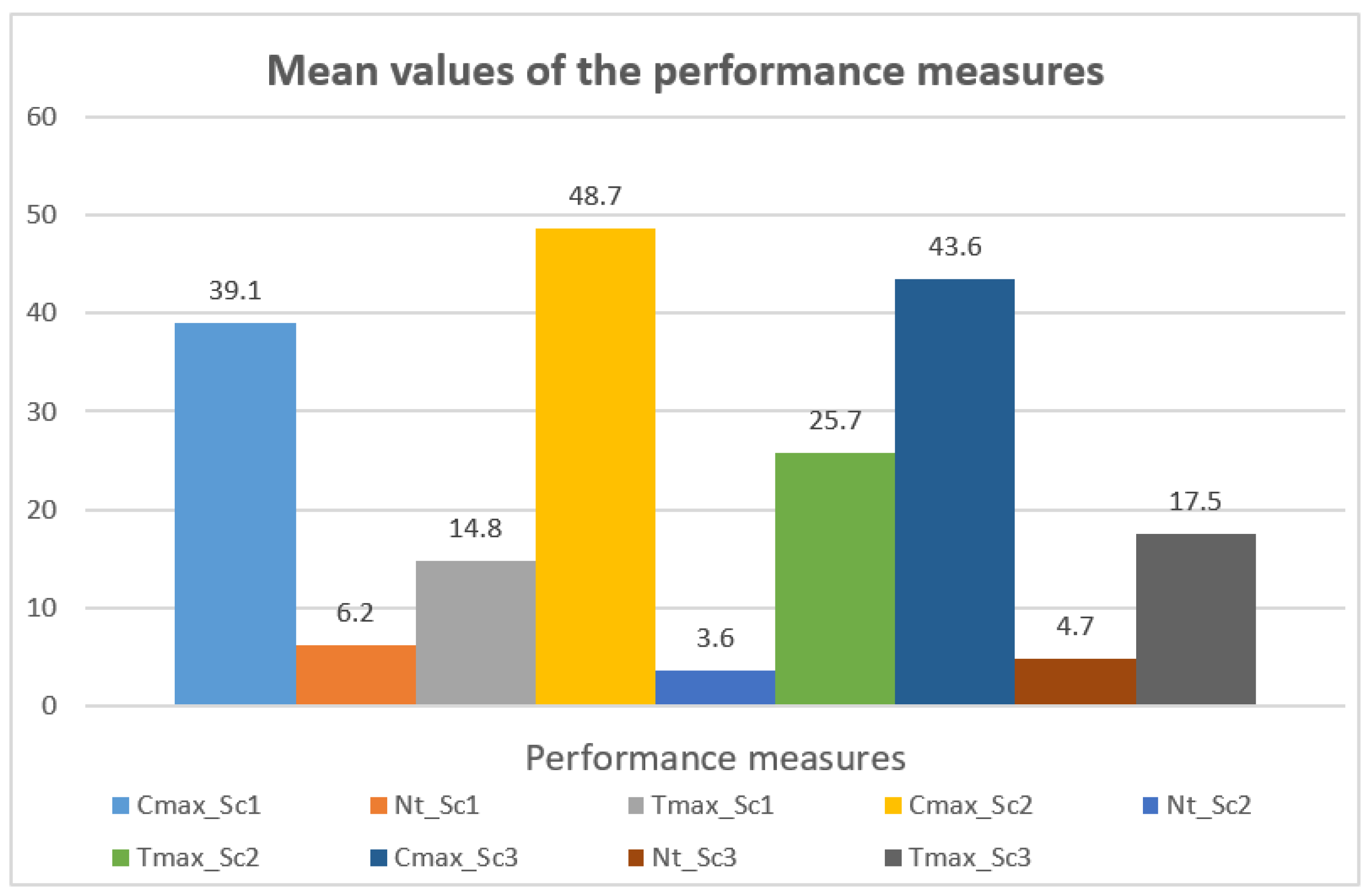



| Nº Machines | Complexity |
|---|---|
| 2 | 4 |
| 3 | 15 |
| 4 | 64 |
| 5 | 325 |
| 6 | 1932 |
| 7 | 8659 |
| 8 | 109,600 |
| 9 | 986,400 |
| 10 | 9,864,100 |
| WCj\Ji | J1 | J2 | J3 | J4 | J5 | J6 | J7 | J8 | J9 | J10 |
| Op.1 | 4| WC2 | 7| WC2 | 4| WC1 | 6| WC2 | 2| WC2 | 6| WC3 | 5| WC1 | 4| WC2 | 5| WC1 | 2| WC3 |
| Op.2 | 2| WC3 | 3| WC3 | 5| WC2 | 7| WC1 | 8| WC3 | 2| WC2 | 8| WC2 | - | - | - |
| Op.3 | 6| WC1 | 9| WC1 | - | - | - | 4| WC1 | 6| WC3 | - | - | - |
| di | 28 | 32 | 27 | 19 | 33 | 34 | 26 | 35 | 31 | 28 |
| WCj\Ji | J1 | J2 | J3 | J4 | J5 | J6 | J7 | J8 | J9 | J10 |
| Op.1 | 3 |WC2 | 8| WC3 | 6| WC1 | 4| WC2 | 7| WC2 | 9| WC1 | 9| WC1 | 3| WC1 | 2| WC1 | 6| WC3 |
| Op.2 | 1| WC1 | 4| WC2 | 4| WC2 | 6| WC1 | 5| WC1 | 4| WC2 | 5| WC2 | - | - | - |
| Op.3 | 3| WC3 | 3| WC1 | 7| WC3 | - | - | 5| WC3 | - | - | - | - |
| di | 34 | 33 | 36 | 31 | 38 | 32 | 39 | 36 | 32 | 39 |
| Scenario (Sck) | Cmax | Nt | Tmax |
|---|---|---|---|
| Sc1 (problem instance 5) | 40 | 7 | 9 |
| Sc2 (problem instance 27) | 57 | 2 | 25 |
| Sc3 (problem instance 27) | 49 | 4 | 10 |
Publisher’s Note: MDPI stays neutral with regard to jurisdictional claims in published maps and institutional affiliations. |
© 2022 by the authors. Licensee MDPI, Basel, Switzerland. This article is an open access article distributed under the terms and conditions of the Creative Commons Attribution (CC BY) license (https://creativecommons.org/licenses/by/4.0/).
Share and Cite
Varela, L.R.; Alves, C.F.V.; Santos, A.S.; Vieira, G.G.; Lopes, N.; Putnik, G.D. Analysis of a Collaborative Scheduling Model Applied in a Job Shop Manufacturing Environment. Machines 2022, 10, 1138. https://doi.org/10.3390/machines10121138
Varela LR, Alves CFV, Santos AS, Vieira GG, Lopes N, Putnik GD. Analysis of a Collaborative Scheduling Model Applied in a Job Shop Manufacturing Environment. Machines. 2022; 10(12):1138. https://doi.org/10.3390/machines10121138
Chicago/Turabian StyleVarela, Leonilde R., Cátia F. V. Alves, André S. Santos, Gaspar G. Vieira, Nuno Lopes, and Goran D. Putnik. 2022. "Analysis of a Collaborative Scheduling Model Applied in a Job Shop Manufacturing Environment" Machines 10, no. 12: 1138. https://doi.org/10.3390/machines10121138
APA StyleVarela, L. R., Alves, C. F. V., Santos, A. S., Vieira, G. G., Lopes, N., & Putnik, G. D. (2022). Analysis of a Collaborative Scheduling Model Applied in a Job Shop Manufacturing Environment. Machines, 10(12), 1138. https://doi.org/10.3390/machines10121138








